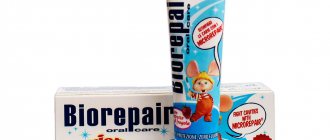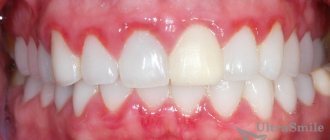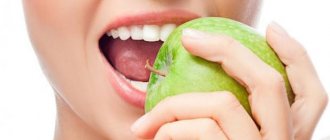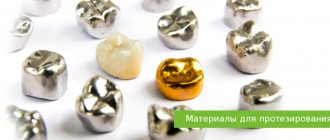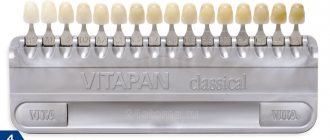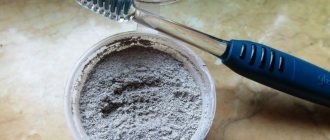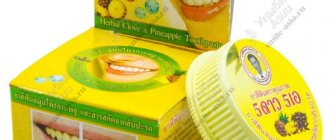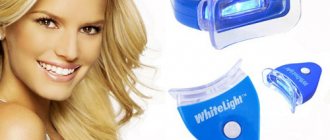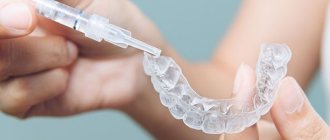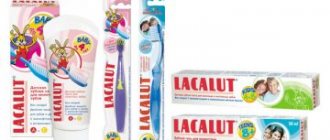Regular and complete oral hygiene is the key to healthy teeth, gums and other structures in this area. Of course, hygiene in this case is based on brushing your teeth, the correct implementation of which today is impossible without the use of toothpaste.
However, the market for oral hygiene products today is crowded. The shelves of stores and pharmacies are full of toothpastes, and the number of their manufacturers is amazing.
In such realities, the question arises - “how to find the best toothpaste that suits me?” To get the answer, you need to have a clear understanding of the classification, as well as the principles for choosing this product for oral hygiene.
What types of toothpastes are there - classification
The ability to choose is an important skill, on which the condition of the structures and health of the oral cavity subsequently depends. An incorrectly selected oral hygiene product can provoke the development of a number of serious problems such as increased tooth sensitivity and bleeding gums.
You may have to visit a dentist before purchasing. The doctor will examine the oral cavity, point out nuances that require adjustments, protect you from making the wrong choice, and tell you what toothpaste you need.
When purchasing, it is important to remember the classification, within which toothpaste is divided into the following types:
- Children's - these do not contain aggressive components, they are known for their gentle effect on the structures of the oral cavity. It is important to pay attention to the age limit indicated on the packaging. When buying children's toothpaste, also make sure that it contains dicalcium phosphate and silicon dioxide, and that the CDV value does not exceed 50 units. It is also important to remember that it is not advisable for an adult to brush their teeth with children’s toothpaste; it is intended primarily for young children and adolescents.
- Whitening - the peculiarity is that this paste contains microparticles of abrasive materials used in dentistry. Thanks to this composition, the whitening helps get rid of stubborn plaque (but does not get rid of tartar). At the same time, tooth whitening paste is not recommended for people with thin enamel or hypersensitive teeth, the problems will worsen.
- Anti-caries - the peculiarities of the chemical composition of this type of hygiene products allow them to penetrate into hard-to-reach places. The components that are included in anti-carious toothpaste help strengthen the enamel layer and reduce tooth sensitivity. This type of toothpaste is used in the initial stages of carious formations; it strengthens the enamel, preventing the spread of caries.
- If there is bleeding, sensitive gums need care. Pastes of this type contain special components (often of natural origin) that have anti-inflammatory, hemostatic and antibacterial effects, and also accelerate tissue regeneration. When using a correctly selected paste of this type, after 20-30 days, inflammation of the gums is eliminated, they stop bleeding, and other problems can be dealt with.
- Hygienic (preventive) - if the previous options had features, then hygienic toothpaste can be called standard. This choice should be made by people with a completely healthy oral cavity, in the absence of complaints of increased tooth sensitivity or thinning of the enamel layer. They have a slight whitening effect, have an antibacterial effect, strengthen enamel and maintain gum health, preventing caries and periodontal disease.
Methods for restoring tooth enamel
There are several ways to restore your teeth to their original structure. The choice of a specific option depends on the degree of damage.
- Fluoridation. The surface is saturated with fluorine, which seals small cracks and scratches.
- Filling. Used for severe mechanical damage: chips, carious lesions.
- Enamel implantation. It is a layer-by-layer application to the surface of a composition similar in structure to that of which the tooth structure is composed.
The listed methods are used as part of professional treatment in dentistry. At home, you can deal with only minor damage. For this purpose, specialized hygiene products are used.
Disadvantages of toothpastes
It was invented to take care of the condition of the structures of the oral cavity and maintain human health. If we exclude second-rate products from unknown manufacturers and talk about good brands, the negative impact of using the paste for a healthy person is minimal (provided it is chosen correctly).
But toothpaste has relative disadvantages:
- Impact on the gastrointestinal tract - some substances contained in toothpaste, penetrating into the gastrointestinal tract, can contribute to the development of dysbiosis or episodic outbreaks of diarrhea. But for brushing your teeth to lead to such results, a person must have serious problems with the condition of the gastrointestinal tract or he must brush his teeth more than 2-3 times a day.
- Some aggressive components penetrate the systemic bloodstream, being absorbed through soft tissues during tooth brushing. However, manufacturers have tried to minimize this risk by adding menthol to the paste, which cools the mucous membrane, reducing the intensity of absorption.
- Restriction in use - refers to those toothpastes that are intended for treatment and have, for example, a whitening effect. This can be used for periods of 2-4 weeks, taking breaks; constant brushing of teeth with such means can be harmful.
- Addictive effect - dentists are convinced that if you brush your teeth with the same toothpaste for 2-3 years or more, its effect decreases. To prevent this, you should choose 2-3 pastes for yourself and change them periodically.
- Colors and flavors – today you can often find red or orange strawberry or peach toothpaste on store shelves (colors and flavors may vary). Even if natural food colorings and flavorings are used, they can cause an allergic reaction. Therefore, it is safer to give preference to classic pastes. The classic option is white.
Question No. 6. Is it possible to whiten teeth with toothpaste in a few days?
No. No toothpaste will make your teeth perfectly white. Unscrupulous manufacturers attract the attention of consumers with sophisticated advertising campaigns, and for greater “effect” they add coarse abrasives or peroxides to their products, which not only remove plaque from teeth, but also harm the enamel.
If the desire to have a snow-white smile is very great, you can get closer to your cherished goal! Professional teeth cleaning and whitening in a dental setting will help achieve the desired result.”
How to choose the right toothpaste
When choosing good toothpastes, it is important to find a product that best suits you according to other criteria. To do this, it is necessary to take into account a number of nuances:
- Purpose – for what purpose are you buying the paste, what task should it perform? Perhaps you have problems with the condition of your oral cavity that require correction.
- Composition – for a particular person, the best paste is made by the components it contains. By paying attention to the composition, you can identify the key components for yourself that must be present or absent in the required paste.
To make it easier for you to choose the best whitening toothpastes for yourself, let’s look at the mentioned nuances in more detail.
Pastes against bad breath
The action of toothpastes that help fight halitosis is aimed at restoring the normal balance of oral microflora, the disruption of which is usually accompanied by excessive proliferation of anaerobes. These substances emit volatile sulfur-containing products that have a pungent odor. Anti-bad breath pastes contain components that suppress pathogenic microflora and act on viruses. In addition, such pastes eliminate dry mouth syndrome, which can also cause halitosis. Antihalitic hygiene products are recommended for bad breath caused by microflora disturbances and dry mouth.
Enzymatic toothpaste gel
Jason Enzyme Brightening
Criteria for prescribing toothpaste
- Inflamed or swollen gums, the presence of bleeding and discomfort are a clear sign that preference should be given to a therapeutic effect. Ideally, you should take a closer look at dental products that contain chamomile or oak bark extract.
- If the shade of the tooth enamel layer changes towards brown or yellow due to bad habits or addiction to drinking coffee, it is better to choose a toothpaste with a whitening effect; it will help clean and brighten the enamel.
- If the enamel is thinned or the teeth are highly sensitive to cold and hot, give preference to gentle pastes, usually these are marked o.
- If you notice even small patches of caries on your teeth, but you can’t go to the dentist now, purchase an anti-caries paste that will slow down the progression of the problem.
Clinical study
RemarsGel is a product that has the unique ability to restore damaged or weakened tooth enamel that is ready for damage; it was originally called Remogel. Research on this drug took place at the Department of Pediatric Therapeutic Dentistry of the Moscow State Medical and Dental University. The purpose of the test was to determine the compliance of the Remogel gel with the possibility and feasibility of its use in dental institutions of the Russian Federation.
During the test, the simplicity and accessibility of the method of using the gel was revealed, and a pronounced remineralizing effect of the gel on foci of demineralization in caries was established. The study showed that Remogel successfully passed medical tests and can be recommended for widespread use in medical practice.
Dissertation of Doctor of Medical Sciences Volkov Evgeniy Alekseevich:
“Pathological changes in the hard tissues of teeth often begin with focal demineralization, leading to dental caries and its complications, as well as non-carious lesions, accompanied by dentin exposure and hyperesthesia. Therefore, mineralization of enamel and dentin, elimination of focal demineralization and hyperesthesia of teeth are a measure for the prevention of more severe pathological processes... A new generation of domestic dental materials and new methods of mineralizing therapy for the pathology of hard dental tissues with the material “BV” (for clinical use - approx. “Gekom”) and a set of gels “Remogel” (now “RemarsGel” - note by “Gekom”) were introduced into practical healthcare at the industry level (included in the State Register).”
Toothpaste composition criteria
- Containing fluoride is a good option, providing a pronounced antibacterial effect and preventing the occurrence of carious lesions. But fluoride negatively affects the condition of bone tissue, so the use of such a paste should be alternated with products that do not contain fluoride.
- Soda-containing sodium carbonate particles in dental products serve as an abrasive, which over time damages the enamel and mucous membranes of the mouth. If you need to whiten your teeth and clean them of plaque, this paste can be used, but it also needs to be alternated.
- Plant components – it’s good if the paste contains extracts of propolis, oak bark, chamomile, and pine needles. These components do not cause harm and constantly maintain the condition of soft tissues.
- The concentration of parabens is not higher than 2% - parabens are preservatives that extend the shelf life of dental products, but when their content exceeds 2%, a health hazard appears.
Why is enamel destroyed?
Enamel is the protective shell of the tooth; it covers the entire surface of the bone tissue and prevents pathogenic bacteria from penetrating into the deep layers of dentin.
The enamel consists of:
- water;
- calcium;
- hydroxyapatite;
- magnesium;
- phosphorus;
- amino acids.
A deficiency of one of the elements can lead to a weakening of the top layer. Apart from this, there are many other reasons that lead to damage.
The main factors of enamel destruction:
- mechanical damage - eating solid food, cracking nuts, biting off thread, opening bottles;
- abrasives in bleaches;
- consumption of excessively hot and cold drinks and food;
- taking antibiotics;
- pregnancy;
- lack of micronutrients;
- smoking tobacco;
- alcohol abuse;
- dishes high in sugar and acids;
- irregular hygiene.
Attention!
To preserve the integrity of the enamel, you need to limit your consumption of foods high in sugar and acids.
Additional selection criteria
- Expiration dates are a less serious, but important nuance. Always check the manufacturing date and expiration date; you may not be poisoned by expired toothpaste, but its effectiveness will be reduced.
- RDA value - this value indicates the amount of abrasive materials in the paste. The higher this indicator, the more thoroughly it cleans the tooth surface, but also damages the enamel layer. If you are not buying a special whitening paste, make sure that this indicator does not exceed 100 for an adult toothpaste and 50 for a child’s toothpaste.
Question No. 1. Is it true that whitening toothpastes are harmful to teeth?
True, if you use cheap, highly abrasive pastes. The abrasive particles they contain scratch tooth enamel like scouring powder scratching a kitchen stove. There are five levels of paste abrasiveness in total. On the packaging it is marked with the index RDA (Radioactive Dentin Abrasion) and indicates the particle size.
When choosing a whitening paste for adults, you should know that its optimal level of abrasiveness is RDA 70-120. Among such pastes, LACALUT White (abrasiveness index - RDA 120), SPLAT whitening Plus, SILCA Arctic White (abrasivity index - RDA 85), PRESIDENT White have proven themselves well. Pastes with a high level of abrasiveness (120-160) should be used to clean pigmented enamel no more than twice a week. Dentists use a range of pastes, for example, PRESIDENT White Plus.”
Comparative analysis of toothpastes
To decide which toothpaste is better to buy in a pharmacy or store, consider the rating of reputable brands that you can choose without fear:
- Aquafresh is a standard option in an affordable price category; you will find it on the shelves of any supermarket. It has no pronounced shortcomings, but also cannot boast of variability.
- Lacalut is another affordable and widespread option; it is preferred when it is necessary to whiten enamel, but you should use them continuously for no longer than 4 weeks.
- Parodontax is a good combined option containing components against bleeding gums, as well as fluoride and soda particles, the price category is average. It is not recommended to use this for a long time without breaks.
- Sensodyne - this representative of the rating is intended for use for medicinal purposes for inflammation of the gums. The effect of use occurs already in the first week, but you cannot use it for a long time.
- ROCS is a popular, but not budget line, in which there is a separate distinction between children's and adult toothpastes. The line includes different types, each of which is designed to solve specific problems.
- Splat is a competitor to the previous one, as they are presented in similar price categories, and also have different product options aimed at eliminating specific problems. In the Splat series you will also find children's toothpaste for different ages.
- Forest balm is an inexpensive but bright representative; these toothpastes contain plant extracts and extracts. A good option for long-term use if you want to improve the condition of your gums.
Author: Zhukov M.A.
What to choose from
Before choosing a toothpaste based on reviews, advice, and popularity of models, it’s a good idea to visit a dentist and get recommendations. Today, three main types of toothpastes are produced to restore enamel.
- Calcium-containing toothpastes, in which the main active ingredient is calcium compounds. The option is more gentle, but not effective in all cases. Most likely, it will not cope with microcracks and erosion.
- Fluoride-containing toothpastes are more powerful. However, their use is not recommended for long-term use. Fluoride compounds can cause the opposite effect in the form of tooth fragility.
- Combined toothpastes containing the two above-mentioned microelements.
In any case, assessing the condition of tooth enamel will not hurt, and most likely will help to avoid mistakes when choosing toothpaste to restore tooth enamel. After all, the choice is not just an oral care product, but, in fact, a medicine. And here the selection criteria are slightly different than mint or fruit flavors. Although this is also important.
Symptoms of enamel destruction
Despite the fact that enamel is very durable, it is vulnerable to many factors. This means that the risk of its destruction and thinning is quite high. Especially in urban environments, where it is not so easy to find quality products, poor environment and a lot of stress.
Deterioration in the quality of enamel leads to serious consequences - it increases the risk of developing caries and other diseases. It is important to remember that although saliva partially regenerates the mineral layer, this is not enough. Restoring the mineral composition requires the use of additional measures.
In different parts of the tooth surface, the thickness of the protective layer is not the same - the closer to the root, the thinner the enamel. The chewing surface, which bears the main load, can have a protective layer of up to 2-2.5 mm. But this does not mean that enamel at the roots is not important. Although this part of the tooth is not subject to much stress when chewing, it is very vulnerable. The spread of microorganisms begins from here. Pieces of food remain under the gums and between the teeth, which creates a good environment for bacteria to multiply and, of course, it is much easier for them to destroy a thin layer of enamel. When this happens, microorganisms no longer have any special obstacles to penetrate deep into the tooth. Therefore, when the enamel is damaged, carious cavities form so easily.
To prevent this from happening, it is important to determine at an early stage that the protective layer is damaged. This can be done based on the following symptoms:
- tooth sensitivity has increased - when exposed to cold, hot food, sour foods, a sharp pinching pain appears;
- pain appears with any small impact, for example, inhaling cold air;
- the teeth have become dull and have lost their shine;
- yellow spots are visible on the surface of the protective layer;
- the enamel in some areas became dull and rough, and the first signs of caries appeared.
